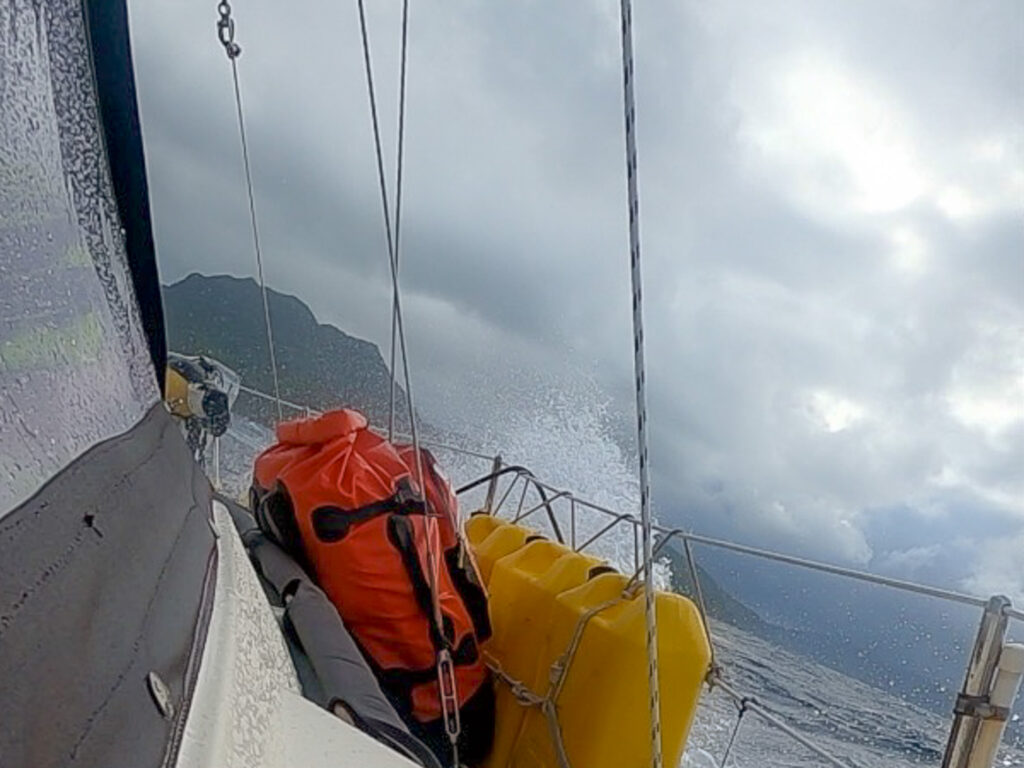After a rollie week in Rarotonga, we picked up our new crew member, James, and set sail on our 6-day passage to American Samoa. Since the passage to Rarotonga was so horribly uncomfortable, I had a lot of anxiety about embarking on another passage that would be twice as long. I was relieved to find that the conditions were forecasted to be generally pleasant, but that there would be another weather system kicking up wind and swell towards the end of our trip, making for a sporty arrival to American Samoa. Whenever the word “sporty” is used to describe sailing, you know it’s not going to be fun.
We sailed for the first couple of days with winds ranging from 15 to 20 knots, then began motoring as the wind died out completely. After running the engine for 48 hours, the wind was expected to fill in at any time, but it seemed to be delayed and slow in coming. Eitan appeared annoyed with the forecast discrepancy and kept asking where the wind was, but I silently thanked the powers above for giving us another calm day.
The wind finally showed up during our last night of the passage, picking up into the 20s, and with it came the squalls, with a system pop up on the radar every hour or so. Normally these squalls would pass off in the distance but occasionally we would get a direct hit, kicking the wind speeds up into the mid-30s and shifting the wind direction, causing the autopilot to be overpowered. After my watch was over, I was thankful that it was my last shift for this trip and planned to sleep until we dropped the anchor.
Unfortunately, this was not to be the case and I was woken up repeatedly as the autopilot was overpowered by the squalls, again and again, during James’ watch. By the time Eitan began his morning watch, the sea state continued to deteriorate with a noticeable increase in swell and howling winds. The weather system we were trying to beat had caught up to us. James remained in the cockpit with Eitan while I laid awake in the cabin (taking an ostrich-style approach) preferring not to see what was going on outside. This strategy didn’t last long as Eitan yelled for me to come on deck as they needed help taking down the sails.
The conditions outside had gotten very ugly and I began to realize that the hardest part of the passage would be just entering the bay. The overcast, ominous skies colored the water gray while the underlying seabed shelf below us amplified the swell into steep, sharp-crested wave sets. I clipped into the safety lines and held on tight as I pulled the rest of the main sail down. With winds sustaining above 30 knots, Eitan sat at the helm, getting pelted with rain as Sierra Wind surfed down the waves, slowly making the final approach into the bay. The last 5 miles of the trip took over two hours and seemed like an eternity. To me, this felt like the scariest conditions we had been in yet.
The seas calmed down but the winds picked up as we rounded the corner into Pago Pago, one of the most protected, natural harbors in the world but the surrounding mountains funnel the wind into the bay, amplifying the wind speed. Eitan coordinated with the harbor master to arrange for customs and immigration to meet us at the dock. After a quick COVID test, we waited at the dock for the officials to arrive and I began cleaning the inside of the boat, which needed a little TLC after the long passage. Customs finally arrived with a drug-sniffing dog and boarded the boat. When I was allowed back onboard, I was very displeased to find dog hair all over the place!
After finishing the check-in process, we headed out to the anchorage, waving to some of our buddy boats as we passed by. We got a call on the radio from our friends on SV Elsewhere who cautioned us about the anchoring conditions, saying they had dragged anchor over five times the previous night. This bay has notoriously bad holding, but we managed to find a spot with plenty of space behind us in case we dragged. The prevailing 30 knots of wind offshore translated to over 40 knots sustained within the bay, causing all the boats in the anchorage to dance around on the ends of their anchor chains. It was finally time to get some rest, if we could under these conditions!



